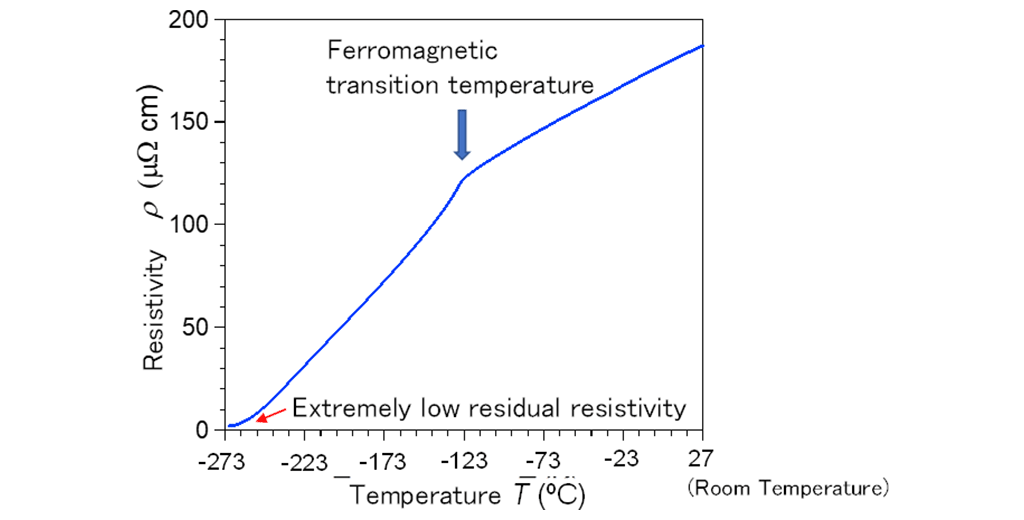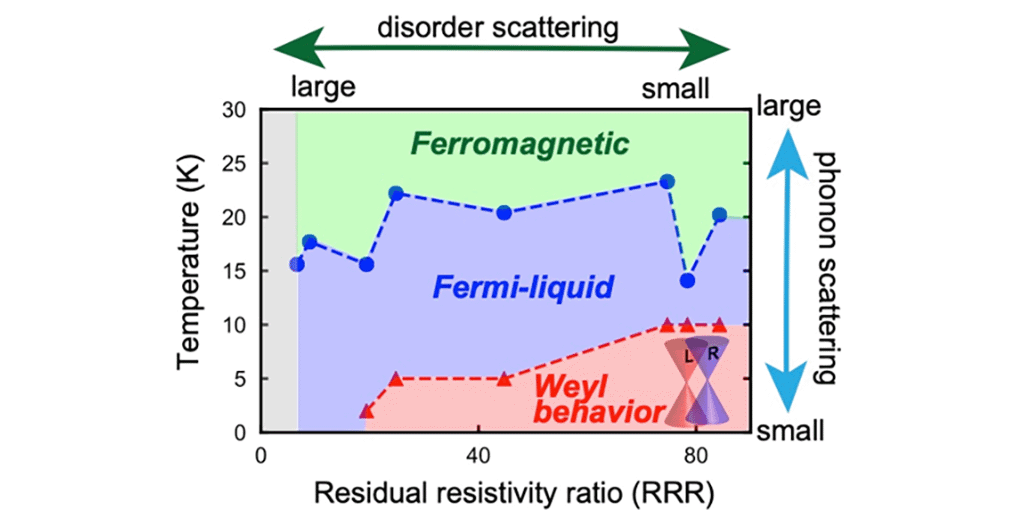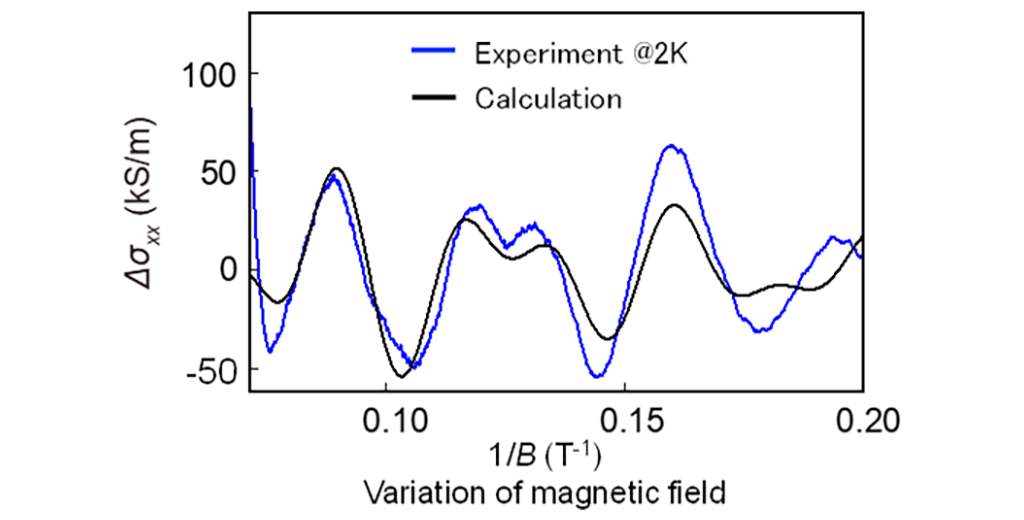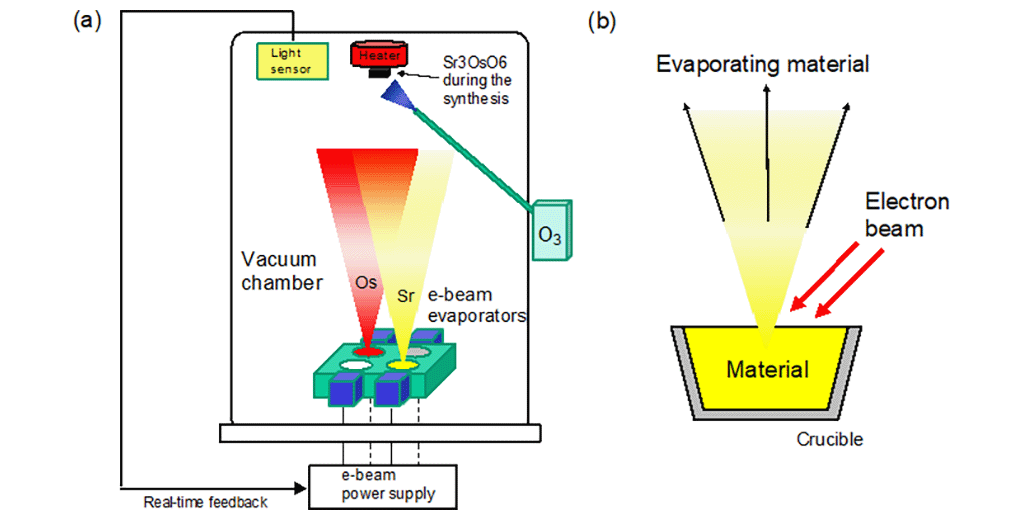Microsoft ends support for Internet Explorer on June 16, 2022.
We recommend using one of the browsers listed below.
- Microsoft Edge(Latest version)
- Mozilla Firefox(Latest version)
- Google Chrome(Latest version)
- Apple Safari(Latest version)
Please contact your browser provider for download and installation instructions.
October 9, 2020
NTT Corporation
The University of Tokyo
Tokyo Institute of Technology
First observation of quantum transport phenomena peculiar to an exotic state
~ Emergence of the magnetic Weyl semimetal state in ultrahigh-quality SrRuO3 thin films ~
Researchers at Nippon Telegraph and Telephone Corporation (NTT; Head office: Chiyoda-ku, Tokyo; President & CEO: Jun Sawada) have succeeded, for the first time in the world, in preparing ultrahigh-quality thin films of SrRuO3*1 and observing quantum transport phenomena in them, which is peculiar to an exotic state called "magnetic Weyl semimetal*2". This work was accomplished by magnetotransport measurements performed in collaboration with the Tanaka Research Group at The University of Tokyo (UTokyo, President: Makoto Gonokami, Bunkyo-ku, Tokyo). They have also revealed the existence of the exotic state in SrRuO3 by theoretical calculation as well, which was carried out in collaboration with the Das Research Group at the Tokyo Institute of Technology (Titech, Headquarter: Meguro-ku, Tokyo; President: Kazuya Masu). Working together, these teams have provided the first set of experimental and theoretical evidence for the existence of the "magnetic Weyl semimetal" state in oxide materials.
SrRuO3 is a metal that exhibits ferromagnetism*3 when cooled to less than -120 ℃. While the ability to prepare large bulk single crystals*4 remains elusive, the large-area single-crystalline thin films necessary for fabricating devices and other purposes have been widely used in research on oxide electronics.*5 The ultrahigh-quality SrRuO3 thin films exploited in this study were achieved through a combination of a sui generis thin-film growth technique developed by NTT for multication oxides and machine-learning-based optimization (process informatics) of the growth conditions. The specimens have an extremely high residual resistivity ratio (RRR),*6 a measure of quality for metallic materials, whose value surpasses the RRR record in SrRuO3 thin films for the first time in 20 years.
The results provide robust evidence for the existence of the magnetic Weyl semimetal state in materials as well as insight into the quantum transport properties in such an exotic state and their emerging mechanisms. As only three years have passed since the first experimental report*7 on the magnetic Weyl semimetal state, applying the present results for device fabrication or other purposes may require considerable time. Nevertheless, the insight gained by the present research will lead to innovative oxide materials and novel quantum devices in the future.
This research was reported in Nature Communications on October 9, 2020.
1. Background
It has recently been revealed that the concept of topology plays a fundamental role in comprehending some quantum states emerging in materials, and such topological materials and exotic states in them are being actively investigated. Among those exotic states, however, the magnetic Weyl semimetal state is still not well understood from the experimental standpoint, though a lot has been predicted theoretically. Observations of the magnetic Weyl semimetal state have been reported in Mn3Sn (The University of Tokyo et al., 2017*7), in Co2MnGa (Princeton University et al., 2019*8), and in Co3SnS2 (Max Planck Institute of Microstructure Physics, Shanghai Tech University et al., 2019*9, and Weizmann Institute of Science et al., 2019*10). However, there is a dearth of knowledge about the quantum transport properties peculiar to that state, especially quantum oscillations*11. Besides, for the design and fabrication of devices in the future, magnetic Weyl semimetals that are versatile and can be readily implemented in single-crystalline thin films are highly desirable. Therefore, researchers have sought to develop such magnetic Weyl semimetals and establish guiding principles to uncover such materials.
2. Achievements
Researchers at NTT Basic Research Laboratories (NTT-BRL), working with those at NTT Communication Science Laboratories (NTT-CSL), have prepared ultrahigh-quality thin films of SrRuO3 using a combination of a unique oxide thin-film growth technique and a machine learning technique (process informatics), both of which they have been refining over many years (Fig. 1). The SrRuO3 films exhibit an extremely high residual resistivity ratio (RRR) *6 value of more than 84, surpassing the RRR record for SrRuO3 thin films for the first time in 20 years.
Measurements of temperature- and magnetic-field-dependence of magnetoresistance in such ultrahigh-quality specimens, carried out with UTokyo, conduced to the first set of quantum transport properties peculiar to the magnetic Weyl semimetal state. Such characteristic transport properties were observed in the low-temperature and high-RRR regime (Fig. 2), indicating the essential importance of sample quality.
When the magnetic Weyl semimetal state exists in materials, it is generally anticipated that five quantum transport properties characteristic to the exotic state should be observed, which stem from linear dispersion *12, violation of time-reversal symmetry *13, and the topological nature*14, inherent to the state (Fig. 3). In the present research, all five properties were observed, providing robust evidence for the existence of the magnetic Weyl semimetal state in SrRuO3. Amongst them, the observation of quantum oscillations (Fig. 4) deserves special mention as it is only allowed for ultrahigh-quality specimens in which electron scattering is sufficiently suppressed. The quantum oscillations have elucidated that quasi-particles*15 specific to the magnetic Weyl semimetal state have light cyclotron masses*16 and high quantum mobility*17 and show Berry phase shift*18, as expected (see Fig. 3).
Furthermore, the existence of the magnetic Weyl semimetal state in SrRuO3 was confirmed by density functional theory *19 calculations carried out by the Titech team, providing the first set of experimental and theoretical evidence for the existence of the magnetic Weyl semimetal state in oxide materials. The present work provides guiding principles for discovering similarly fascinating materials and will certainly contribute to further developments in this research field.
In addition, this is the first successful observation of the magnetic Weyl semimetal state in single-crystalline thin film specimens, which have high compatibility with device fabrication processes. As we are still at the dawn of this research field, applying the present results to something practical such as device fabrication may require considerable time. Nevertheless, topologically protected quantum states like magnetic Weyl semimetal have high immunity against impurities and noises. Therefore, the insight gained in the present work will contribute to the design of quantum devices operating on novel principles in the future.
3. Technical Features
Preparation of the ultrahigh-quality SrRuO3 thin films
We prepared the SrRuO3 thins films with a perovskite structure*20 (Fig. 5a) by means of molecular beam epitaxy*21 augmented by machine-learning techniques (process informatics). To grow high-quality SrRuO3 thin films, precise control of the flux rates of each constituent cation (Sr, Ru) is mandatory. Although controlling the flux of Ru is a challenge because of its high melting point (higher than 2000℃), we have succeeded in precisely controlling its flux rate as well as that of Sr. We accomplished this by monitoring the flux rates with an atomic emission spectrometer and feeding them back to the evaporation source power supplies in real time (Fig. 7), which enabled preparation of ultrahigh-quality SrRuO3 thin films with the Sr and Ru atoms arranged in a highly ordered structure (Fig. 5b).
4. Future plans
In our quest for better comprehending the fundamentals of the magnetic Weyl semimetal state in SrRuO3, we will further investigate the electronic structures of SrRuO3 using advanced spectroscopy techniques offered by synchrotron radiation facilities.*22 At the same time, as a part of a strategy toward quantum devices, we will examine whether or not we can electrically control the transport properties of Weyl particles in a manner similar to that in conventional semiconductor devices.
Paper publication information
"Quantum transport evidence of Weyl fermions in an epitaxial ferromagnetic oxide"
Kosuke Takiguchi, Yuki K. Wakabayashi, Hiroshi Irie, Yoshiharu Krockenberger, Takuma Otsuka, Hiroshi Sawada, Sergey A. Nikolaev, Hena Das, Masaaki Tanaka, Yoshitaka Taniyasu, and Hideki Yamamoto
Nature Communications (2020): https://doi.org/10.1038/s41467-020-18646-8.
Glossary
- Single-crystalline thin film
Crystals are solids in which atoms are periodically and orderly arranged and thus form lattices. Single crystals are ones that have only a single atomic arrangement over an entire volume. Samples whose thicknesses range from one atomic layer to about several tens of micrometers (1 µm = 1×10-6 m) are called thin films. Single-crystalline thin films are prepared on single-crystalline substrates. In this study, single-crystalline SrRuO3 thin films with the thickness of approximately 60 nm (1 nm = 1×10-9 m) were grown on single-crystalline SrTiO3 substrates. For microfabrication toward high-performance devices, it is necessary to prepare samples in the form of single-crystalline thin films with submicrometer thicknesses. - Magnetic Weyl semimetal state
Two kinds of Weyl semimetal states--non-magnetic Weyl semimetal and magnetic Weyl semimetal states--can emerge in solid crystals. Magnetic ordering in matrix crystals, if any, has nothing to do with the emergence of the non-magnetic Weyl semimetal state; however, it plays an essential role in the emergence of the magnetic Weyl semimetal state. In 2015, multiple research groups spotted evidence for the former state in TaAs. Two years later in 2017, a research group at UTokyo et al., discovered the latter one in Mn3Sn (see, *7 of this glossary). The present study spotted evidence for the latter state in SrRuO3. Behaviors of collective electrons in Weyl semimetal states can be understood as those of quasiparticles*15 called Weyl particles. These eponymous particles are massless, which was predicted by Hermann Weyl, a German physicist, in 1929. Despite tremendous efforts in the field of high-energy physics (elementary particle physics), the particles had not been discovered. Recently, it was revealed that the particles can exist in the exotic states (Weyl semimetal states) achieved in some crystalline materials. Hence, research on these states and particles is very active in the field of solid state physics. - Ferromagnetism
Ferromagnetism is a magnetic state in a material that enables it to behave as a magnet. In the ferromagnetic state, the net magnetic moment is large since the magnetic moments of the constituent atoms are aligned (Fig. 6a). - Bulk single crystals
In contrast to thin films (see *1 of this glossary), the term "bulk single crystals" is often used for single crystals whose dimensions are equal to or larger than several millimeters. Unlike thin films, bulk single crystals are independent, with no need of substrates. The availability of large single crystals depends substantially on the materials, from millimeter-scale ones for basic research to 12-inch Si wafers for industrial use. - Oxide electronics
Electronics collectively refers to science and technology in which electrons are exploited to achieve some designated functions by fabricating junctions, devices, and circuits. On the other hand, oxides are materials composed of oxygen and one or more other elements (mainly metallic ones). Oxide electronics is a research field seeking novel functions that cannot be realized using conventional materials. - Residual resistivity ratio
Materials are often classified as metals, semiconductors, and insulators, by using electrical conductivity (or resistivity) as a measure. Generally, metals show lower resistivity as they are cooled down from ambient temperature and the resistivity asymptotes to a certain value (residual resistivity) at the lowest temperature unless a superconducting transition takes place. The residual resistivity ratio (RRR) is often defined as the ratio of resistivity at ambient temperature to the residual resistivity. For metals, a higher RRR means better sample quality with fewer defects or impurities. - The first experimental report on the magnetic Weyl semimetal state
As mentioned in *2 of this glossary, it has been only three years since a research group at UTokyo et al., spotted the first experimental evidence of the magnetic Weyl semimetal state in a material (Nature Materials Vol. 16 (2017) 1090). They chose antiferromagnetic [Fig. 6(b)] Mn3Sn as the target material and succeeded in observing negative magnetoresistance [(d) in Fig. 3] stemming from chiral anomalies among various transport properties peculiar to magnetic Weyl semimetals. They also succeeded in observing electronic structures specific to Weyl semimetals using angle-resolved photoemission spectroscopy (ARPES). - Co2MnGa (Princeton University et al.)
They spotted evidence of the magnetic Weyl semimetal state in ferromagnetic [Fig. 6(a)] Co2MnGa using a combination of ARPES measurements and theoretical calculations (Science Vol. 365 (2019) 1278). - Co3SnS2 (Max Planck Institute of Microstructure Physics, Shanghai Tech University et al.)
They spotted evidence of the magnetic Weyl semimetal state in ferromagnetic [Fig. 6(a)] Co3SnS2 by using a combination of ARPES measurements and theoretical calculations (Science Vol. 365 (2019) 1282). - Co3SnS2 (Weizmann Institute of Science et al.)
They spotted evidence of the magnetic Weyl semimetal state in ferromagnetic [Fig. 6(a)] Co3SnS2 using a combination of scanning tunneling microscopy (STM) measurements and theoretical calculations (Science Vol. 365 (2019) 1286). - Quantum oscillations
Quantum oscillations are oscillations of physical quantities, such as electrical conductivity, that occur when an applied magnetic field is systematically varied. These phenomena stem from quantized energy levels (Landau levels) formed in materials under magnetic fields. Very high-quality crystals with minute defects and impurities as well as low-temperature measurements are prerequisites for the observation of this type of oscillation. While quantum oscillations themselves are not specific to magnetic Weyl semimetals (they are observed in common crystals), the present research, for the first time, spotted quantum oscillations for which Weyl particles*2 in the magnetic Weyl semimetal state are responsible. Transport measurements with magnetic field and temperature systematically varied allowed us to obtain information on cyclotron mass*16 [Fig. 3(b)], quantum mobility*17 [Fig. 3(c)], and the Berry phase*18 [Fig. 3(e)]. - Linear dispersion
The relationship between energy E and wavenumber k for quantum particles is generally called dispersion. For example, dispersion is quadratic (E ∝ k2) for free electrons in a vacuum, while it is linear (E ∝ k) for photons, which are massless. Unlike free electrons, dispersions of electrons in solids are generally more complicated owing to their interactions with periodically arranged ions and are thus depicted as multiple curves. Such dispersions could happen to include linear ones, such as that for massless photons, whose existence is a necessary condition for exotic states such as magnetic Weyl semimetal. - Violation of time-reversal symmetry
Information on whether or not molecules and solids have space-inversion symmetry sometimes helps in understanding the properties they exhibit, and so does information on time-reversal symmetry. Time-reversal operation means that time is flipped from t to -t while spatial coordinates remain unchanged, and violation of time-reversal symmetry means the states of the system of interest before and after this operation are not identical. For example, in a model where the magnetization of each atom indicated by arrows in Fig. 6(a) (a schematic of ferromagnetic ordering state) stems from local current loops, the current direction flips by the time-reversal operation, leading to a flipped magnetization direction, and, accordingly, the state after the flip is not identical to the original one. In this sense, time-reversal symmetry is broken in a ferromagnetic ordered state, which is also the case in the magnetic Weyl semimetal state. Besides, the chiral-anomaly-induced negative magnetoresistance [(d) in Fig. 3] resulting from the violation of time-reversal symmetry is a unique quantum phenomenon where current flow becomes maximum (namely magnetoresistance becomes minimum) when the applied magnetic field and current are in a parallel configuration. - Topological nature
Topology in condensed matter physics is a concept exploited when classifying materials and investigating their properties based on the universal nature conserved by continuous deformation of an intended object. A traditional example is that a coffee mug and a doughnut cannot be distinguished topologically since both have one hole in them and the former can be deformed into the latter (and vice versa) without cutting or gluing. Here, topological nature refers to the nature of a material that can be figured out by using the concept of topology. The magnetic Weyl semimetal state has such a nature. - Quasi-particles
A group of many particles, such as electrons in metals and atoms in crystals, can collectively behave as if they are one particle, and such particles are called quasi-particles. - Cyclotron mass
Charged particles, such as electrons, in a magnetic field receive electromagnetic force called Lorentz force and their motion is curved in the direction perpendicular to both the original charge motion and the magnetic field directions. As a result, in crystals of very high quality, where scattering events due to impurities and defects are sufficiently suppressed, they move in a helix along the magnetic field axis. This motion is called cyclotron motion. While the free electron rest mass in a vacuum is approximately 9.1 × 10-31 kg, electrons in crystal solids sometimes behave as if they are massless or have 1,000 times larger masses governed by dispersions (see *12 of this glossary) they follow in crystals. Such a mass determined based on behaviors in crystals is called effective mass, and cyclotron mass is determined from cyclotron motion observations. In the present study, the researchers measured cyclotron masses of Weyl quasi-particles*15 and revealed their very light cyclotron masses, as expected from the linear dispersion*12 they follow. - Quantum mobility
Mobility is a measure often used in solid state physics to describe how easily and how fast charged particles, such as electrons, can move when voltage is applied. The unit of mobility is cm2/V·s, which can be interpreted as multiplication of cm/V and cm/s (the latter is a unit of velocity). Quantum mobility means mobility determined by means of quantum oscillations*11. In the present study, the researchers measured quantum mobility values of the Weyl quasi-particles*15 and revealed that they are very high, as expected from the linear dispersion*12 the particles follow. - Berry phase shift
Consider a situation where an operator (called a Hamiltonian) describing a quantum state (called a wavefunction) depends on wavenumber k*12. When k is slowly varied with time and eventually returns to its original value, the wavefunction gains a Berry phase that is dependent on how k is varied. In measurements of quantum oscillations, the phase of the oscillations can shift as a result of k variation accompanied by cyclotron motion (see descriptions in *16 of this glossary) of the quasi-particles*15, and the shift is called a Berry phase shift. In the present study, the researchers observed quantum oscillations that Weyl quasi-particles show and revealed that the Berry phase shift actually takes place, in accordance with expectations and theoretical calculations (Fig. 4). - Density functional theory
According to density functional theory, the energy of electrons in solids can be determined by using spatially dependent electron density n(r). The word "functional", which means the function of another function, is used since the energy is calculated as a function of n(r), which is already a function of r. Based on this theory, electronic states in materials can be calculated and predicted from the fundamental equation that electrons follow, without experimental data. - Perovskite structure
In crystals, atoms are regularly ordered and form lattices. There are many kinds of atomic arrangements (crystal structures) and representative ones have specific names. One such arrangement is called the perovskite structure (Fig. 5). It is widely known that many complex oxides take the perovskite structure. Recently, iodides and chlorides that take the perovskite structure have also been intensively studied for the next generation of solar cells. - Molecular beam epitaxy
Molecular beam epitaxy (MBE) is a method for growing high-quality single-crystalline thin films. In MBE, thin films crystallize via reactions between molecular or atomic beams of the constituent elements on heated single-crystal substrates (Fig. 7). Generally, this method is used to prepare single-crystalline thin films of some already existing materials to make superlattices, junctions, and devices. In this study, the researchers prepared ultrahigh-quality thin films of SrRuO3 using this method, augmented by machine learning techniques (process informatics), and revealed the existence of the magnetic Weyl semimetal state in this material, which had been hidden due to inferior sample quality. - Synchrotron radiation facilities
In synchrotron radiation facilities, we can use lights with various wavelengths (synchrotron radiation), such as ultraviolet rays and X-rays. Synchrotron radiation is emitted from accelerated electrons that travel in a huge ring in an ultrahigh-vacuum environment. The versatile capabilities of such facilities include emissions of intense and variable-wavelength lights, which enable us to perform many kinds of high-resolution spectroscopies to investigate the physical properties of specimens in detail. Therefore, synchrotron radiation facilities are also very useful for materials science research. In Japan, there are several synchrotron facilities, including SPring-8 in Hyogo Prefecture and the Photon Factory in Ibaraki Prefecture.
Figures
 Figure 1. Temperature dependence of resistivity for the world highest quality SrRuO3 thin film. The residual resistivity ratio (RRR), defined as the ratio of resistivity at room temperature to that at the lowest temperature (residual resistivity), exceeds 84.
Figure 1. Temperature dependence of resistivity for the world highest quality SrRuO3 thin film. The residual resistivity ratio (RRR), defined as the ratio of resistivity at room temperature to that at the lowest temperature (residual resistivity), exceeds 84.
 Figure 2. Temperature-vs-RRR phase diagram for SrRuO3.
Figure 2. Temperature-vs-RRR phase diagram for SrRuO3.
 Figure 3. Five characteristic transport properties expected for magnetic Weyl semimetals.
Figure 3. Five characteristic transport properties expected for magnetic Weyl semimetals.
 Figure 4. Quantum oscillations arising from the Weyl quasi-particles in SrRuO3 (blue solid line). Two oscillations with different frequencies are superimposed, reflecting the existence of two kinds of orbitals stemming from the magnetic Weyl semimetal state. The experimental result (blue) coincides well with the calculation result (black), where the effect of the Berry phase shift*18 is taken into consideration.
Figure 4. Quantum oscillations arising from the Weyl quasi-particles in SrRuO3 (blue solid line). Two oscillations with different frequencies are superimposed, reflecting the existence of two kinds of orbitals stemming from the magnetic Weyl semimetal state. The experimental result (blue) coincides well with the calculation result (black), where the effect of the Berry phase shift*18 is taken into consideration.
 Figure 5. (a) Specimen structure (left) and crystal structure (right) for SrRuO3 thin films on SrTiO3 substrates. Both of the materials take the perovskite structure. (b) Electron microscopy image of a specimen.
Figure 5. (a) Specimen structure (left) and crystal structure (right) for SrRuO3 thin films on SrTiO3 substrates. Both of the materials take the perovskite structure. (b) Electron microscopy image of a specimen.
 Figure 6. Schematic illustrations for (a) ferromagnetic, (b) antiferromagnetic, and (c) paramagnetic (non-magnetic) states. Each arrow represents magnetization of each atom.
Figure 6. Schematic illustrations for (a) ferromagnetic, (b) antiferromagnetic, and (c) paramagnetic (non-magnetic) states. Each arrow represents magnetization of each atom.
 Figure 7. (a) Schematic diagram of the molecular beam epitaxy system used in this study. We control the elemental fluxes of both Sr and Ru by feeding the measured flux rates back to the power supply of the e-beam evaporators in real time. The flux rates are measured with a light sensor that detects specific wavelength lights emitted from the evaporant fluxes. (b) Schematic illustration of the e-beam evaporation. Electron beam irradiation increases the temperatures of the source materials. A larger e-beam current gives a larger flux rate.
Figure 7. (a) Schematic diagram of the molecular beam epitaxy system used in this study. We control the elemental fluxes of both Sr and Ru by feeding the measured flux rates back to the power supply of the e-beam evaporators in real time. The flux rates are measured with a light sensor that detects specific wavelength lights emitted from the evaporant fluxes. (b) Schematic illustration of the e-beam evaporation. Electron beam irradiation increases the temperatures of the source materials. A larger e-beam current gives a larger flux rate.
Press contact
■Nippon Telegraph and Telephone Corporation
Science and Core Technology Laboratory Group, Public Relations
science_coretech-pr-ml@hco.ntt.co.jp
Phone: +81-46-240-5157
■The University of Tokyo
School of Engineering, Public Relations Office
kouhou@pr.t.u-tokyo.ac.jp
Phone: +81-70-3121-5626
■Tokyo Institute of Technology
Public Relations Section,
media@jim.titech.ac.jp
Phone: +81-3-5734-2975
Information is current as of the date of issue of the individual press release.
Please be advised that information may be outdated after that point.
NTT STORY
WEB media that thinks about the future with NTT










